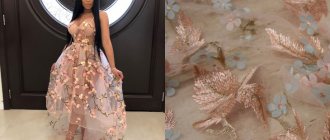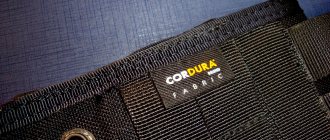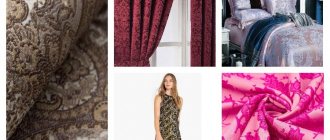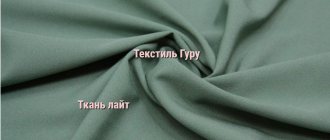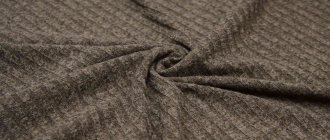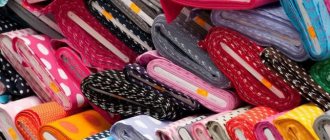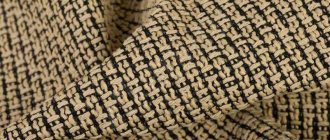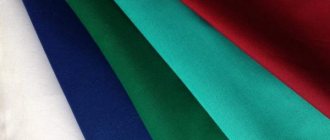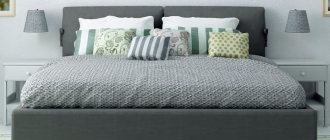Composition and properties
Lining fabric is necessary for decorating things from the wrong side. This is necessary to preserve the clothing and prevent rapid wear or contamination. During wear, all lining fabrics are subject to strong friction.
Main qualities of the lining:
- with frequent washing, the material should maintain a presentable appearance;
- it is necessary that the paint on the fabric is of high quality and resistant, especially under friction and other types of impact;
- the lining should be easy to process;
- the material must have hypoallergenic properties;
- the fabric must have good hygienic characteristics;
- the material should not be highly electrified.
The lining should be light, durable, wear-resistant, shrink slightly during washing, and also have an affordable price and durable color of the material.
Classification of lining fabrics:
- the material is divided according to its composition into cotton, silk, wool, homogeneous and mixed structure;
- according to the production method it can be fabric, knitted fabric or fur;
- the material can be made of yarn or thread;
- Based on color, it is divided into bleached, dyed or variegated.
The lining must match the properties of the outer fabric. It is usually divided according to the density of the material into light, medium and heavy fabrics. There is a special GOST for lining fabric with chemical fibers and yarn. Based on such standards, the manufacturer must produce only high-quality materials that meet all necessary requirements.
There is another classification based on composition; lining material is divided into:
- natural fabric (flannel or natural silk);
- non-natural fabrics (the most famous is viscose);
- synthetic (mesh or polyester).
This is interesting: Aluminum fabric with a membrane: description, features
What is the lining for?
Let's first talk about what functions lining fabric should perform.
- Giving a neat look to the inside of the product: all seams remain inside, and an additional decorative effect is possible from the color and pattern of the selected fabric.
- Protects the main fabric from wear and stretching
- Makes the product easier to use: easy to put on, no sticking of the main fabric.
- Absorption of excess moisture.
In order for the lining fabric to provide all this, it must have certain characteristics. Even if the material is thin, it must be dense so that the internal seams do not show through. Since it is the lining fabric that bears the main load, it must be durable . In order for the lining fabric to provide comfort and convenience when wearing, it must be smooth , sliding, not wrinkled and not electrified. The property of a material to absorb moisture is called hygroscopicity . In addition, the lining fabric must be resistant to washing and dry cleaning, and also show minimal shrinkage.
Lining fabrics are usually produced using three methods of weaving threads.
Satin weave produces a smooth and very pleasant to the touch material with a shiny surface. This fabric is used for lining expensive outerwear (for example, fur coats). However, puffs often appear on this fabric and it is better not to use it where there is a possibility of contact with sharp objects (buckles, zippers, etc.).
Twill weave produces a dense and durable material that has a pronounced diagonal rib. Fabric with a twill weave must be carefully aligned and cut to avoid distortions.
Plain weave produces a smooth material with the same surface on both the front and back sides. This fabric holds its shape well, does not stretch and does not form a snag.
Let's take a closer look at the main lining fabrics.
Acetate silk (acetate) is a soft, silky fabric that is produced from cellulose using chemical reagents. This is a very beautiful inexpensive material, pleasant to the touch. It “breathes”, but does not absorb moisture well and breaks easily when wet. Requires washing on a delicate cycle up to 30C, dries quickly. Acetate silk should be ironed at a low iron temperature. You should not use acetate as a lining on outerwear where increased wear resistance is required.
Viscose is also made from cellulose fibers, but, unlike acetate, it is not electrified. Viscose glides well, is inexpensive, and is therefore an excellent choice as a versatile lining material.
Taffeta is used to sew skirts and dresses. This is a beautiful shiny fabric of different densities, it is quite strong and durable, but it is demanding to care for: delicate washing up to 30C and special detergents are required.
Polyester is a very durable and inexpensive synthetic fabric; its wear resistance allows it to be used for duplicating outerwear and bags.
Do not use polyester for clothing that touches the body, this material is non-hygroscopic!
When choosing a lining material, you need to take into account the density and color of the main fabric, as well as the type of product itself.
Here are some tips to help you make your choice.
Adviсe
- Choose thin lining fabric of natural composition for clothes for the hot summer. Choose thick lining fabric for clothing intended for cold weather.
- Choose the color of the lining based on the features of the model. You can choose a color to match or add a contrasting color. However, be sure to check how the main and lining fabrics behave when washed, whether they will fade on each other.
- In some cases, only parts of the product are duplicated with lining. So, sometimes the lining on trousers is done only on the front halves, and on summer jackets - up to the shoulder blades.
- There is a special “sleeve” and “pocket” fabric for duplicating sleeves in jackets and internal pockets. This material is stronger than regular lining fabric and less expensive.
- The lining fabric for bags should be dense. In addition to special fabrics, thick cotton and raincoat fabrics with water-repellent impregnation are well suited.
- For warm outerwear and bags, you can use lining fabric quilted with synthetic padding.
Compound
The material is woven from natural, artificial or synthetic fibers. So the mesh fabric can contain linen, cotton, wool or silk. Often elastane or polyester is added to natural threads. The fabric is also woven from viscose. The result is an elastic material with a slight shine and excellent hygroscopic properties.
The most common type of mesh found on sale is synthetic mesh. It can be made from:
- polyamide - the material is elastic and abrasion-resistant.
- polyester - it makes a durable mesh fabric. It holds its shape well and does not require special care.
- elastane - the fabric stretches well, clothes made from it fit the figure.
- neoprene - a mesh fabric made of it does not allow water or air to pass through, and retains heat well. Most often, wetsuits are made from it.
The density of the material depends on the thickness of the threads of the source material and the characteristics of the weaving process. Technical fabrics are produced with a density of up to 100 g/m2, household fabrics - 15-40 g/m2.
Application
This type of textile is used for a variety of purposes. Depending on the rigidity and size of the holes, the purpose of the canvas is determined. Thus, soft elastic fabrics are used for sewing women's clothing, and denser fine-mesh fabric is used as a lining in the production of wedding or evening dresses with a full skirt.
The mesh is used in the manufacture of:
- evening, cocktail and wedding dresses;
- elegant blouses and tunics;
- skirts;
- dance and stage costumes;
- as a lining material;
- curtains and light curtains.
Sometimes mesh is used to make summer socks and socks, furniture blankets, kitchen napkins, as well as children's bows and ribbons.
- Equipment
- Instructions
Which sewing machine to choose: the best models from budget to computerized
Rating of sewing machines
Review of models for industrial and domestic use
The best models for home and production according to customer reviews
Is it possible to return a piece of fabric back to the store?
Let's take a closer look at the nuances of returning
Caring for mesh items
To understand how to properly care for certain things that are made from a wide variety of materials, there is a table developed by specialists. All necessary requirements for storing, washing and ironing clothing are indicated on the special label of each T-shirt, jacket, tank top, trousers and many accessories used. A hint for buyers is on the reverse edge of any product purchased in a clothing and shoe store.
Every person can understand the characteristics; you just need to look at the back of the product and look at the pictures and indicators. When manufacturing a product recommended for sale, all the nuances are noted using markings. There is an international ISO standard for this. Signs depicted on the inside of the outfit may reflect the following indicators: washing, drying, ironing or bleaching shirts, prohibition of specific actions, professional cleaning, delicate mode for particularly sensitive fabrics.
Shirt material
Inappropriate care of the mesh can lead to inevitable consequences. A list of special rules has been compiled that must always be followed in order not to bring dresses, suits and skirts to an inevitable state. After all, if the outfit is damaged, then nothing can be corrected or changed for a better outcome.
Colors
The range of lining materials is impressive. In the production of clothing, not only the standard shades of white, black and blue are used. Red, pink, yellow and light green fabrics are often used. Double-sided lining fabric is in fashion and serves as an excellent decoration for any outerwear. Many coats and suits began to be sewn using multi-colored linings and patterned materials. They add character and style to the look.
Recently, the lining and the main fabric may not match in color and may be contrasting.
Advantages and disadvantages
The advantage of the mesh is its extraordinary lightness and airy texture. However, such delicate material should be handled with extreme caution, especially with those options that have thin fabric partitions and large spaces between them.
Pros:
- ease;
- elasticity;
- spectacular appearance;
- dimensional stability;
- multifunctionality;
- abrasion resistance;
- tendency to drape;
- breathability;
- hygroscopicity.
Minuses:
- difficulties in working with the material;
- hard mesh may irritate sensitive skin;
- sensitivity to ultraviolet radiation.
The mesh is considered a strong and durable material, however, during use it is necessary to carefully ensure that the fabric does not get caught on anything.
This is interesting: Burlap in the interior: on the walls, in crafts, descriptions
Diagonal characteristics
This fabric has a characteristic feature by which it can be distinguished even by a non-professional - a clear, pronounced scar of small height, but straight and always visible in oblique light. The result is a rib with twill weave of fibers: when the weft is shifted by one thread, the result is an overlap of two, sometimes three warp threads. This results in what weavers call a “bias rib” - this is a rib at an angle of 45 degrees to the edge of the fabric or, in other words, diagonal or diagonal.
The density of the fabric is much higher than that of conventional woven material due to the twisting of the threads used in production, and it reaches on average approximately 180-190 g/sq.m. Moreover, on the front side the scars are more pronounced than on the almost smooth back side. Twill weave creates additional compaction of the fabric, makes it less elastic, but more resistant to wear; it is almost impossible to tear or fray such fabric unless special efforts are made.
Depending on the threads, diagonal fabrics can be:
- cotton or cotton;
- woolen;
- silk;
- with the addition of synthetic fiber;
- mixed.
In our store you can also buy inexpensive diagonal fabric made of viscose, linen, knitted diagonal fabric, jacquard models, with lycra in the composition... It can be a thin fabric, intended for sewing a dress or blouse, or a denser material - for a coat or suit. Separately, it is worth highlighting the diagonal lining, plain or printed.
Cotton is most often used for the production of diagonal fabric, since initially the main purpose of durable fabric is sewing work and tourist clothing, overalls, robes and suits, and uniforms. The fabric does not lose its appearance at all; it is permanently dyed blue, gray, black, and brown. If the buyer needs a fabric of a different color, then various pigments are added to the dyeing mixture, but during washing the temperature regime must be carefully observed; you cannot wash with laundry soap.
Historians tend to attribute the appearance of diagonal fabric to the end of the 19th century, and confidently associate the use of the fabric with the name of the French cavalry general Gaston Galife. Having been wounded in the thigh, the general was unable to wear the military uniform accepted at that time, and a model of military uniform was designed for him to hide the defects of the wounded thigh. A little later, men's riding breeches were adopted as a military uniform in various branches of the military, and durable diagonal wool fabric, which was able to withstand heavy loads, was perfect for sewing. Breeches remained in military tailoring almost until the middle of the 20th century, and in cavalry trousers were used everywhere, because they were not only comfortable when putting a person in the saddle, but also practical to use.
It must be especially said that regardless of the material of the fibers, the fabric remains durable, and even silk fabrics with a diagonal rib retain their original appearance perfectly. Diagonal suits are used in tailoring exclusive items; they look sophisticated and expensive, despite the apparent simplicity of the cut. The addition of elastane to the weave makes the fabric more pliable in creating unique clothing models, while the fabric does not shrink or lose its original shape when worn.
Inexpensive diagonal cotton fabric “breathes” perfectly, does not impede heat exchange processes, it does not overheat a person even in hot workshops, and woolen fabric is perfect for cold climates, retaining heat for a long time.
Among all types of diagonals, fabric made from silk fibers looks the most elegant, and such fabrics are quite expensive in price. But products made from them are pleasant on the body, hold their shape perfectly, and the flowing silhouette of practical skirts and dresses does not in the least detract from the durability of the products.
To sew work uniforms or clothes for fishermen and hunters, inexpensive synthetic diagonal is used, which, in addition to elasticity and strength, has an important distinctive property - the fabric, even without special impregnation, is almost impermeable to moisture. The canvas practically does not “breathe”, but it retains heat perfectly, and on cold days such clothing is simply irreplaceable for tourists and fishermen.
Tulle is a light fabric for fashionable skirts or tulle for summer areas
We all know tulle - a transparent mesh fabric that resembles tulle. Ask anyone what this fabric is associated with, and without hesitation everyone will answer - with the image of a gentle bride. And for good reason, because tulle is often used to create wedding dresses, and veils are also made from it. But not only the bride’s decoration is created from this weightless fabric. Tulle fabric has found application in many areas, including often used to decorate rooms and create unforgettable decor.
Where to find tulle
You can buy tulle in specialized stores, which are located in all cities of Ukraine. But recently, more and more often, buyers prefer to place orders through online stores. Here prices are cheaper, and you can purchase goods at retail or wholesale, directly from the manufacturer. In addition, it is possible to read customer reviews and look at photos of existing products.
Properties of tulle
Tulle has many positive aspects. Firstly, it is elastic, so it looks especially great in folds and ruffles. Secondly, things made from this decorative “mesh” perfectly retain their shape and do not wrinkle. Thirdly, which is an undeniable advantage, the material practically does not get dirty, and all thanks to the special structure created by special cells.
The grid also has a minus. Thus, assembled in several layers, it practically does not allow air to pass through, the body under it does not “breathe”, and, therefore, sweats and sweats, which is unpleasant and causes a lot of discomfort. But this drawback is easily eliminated - a natural fabric lining is used under the mesh.
Types and methods of using tulle
It would seem, what design options can a decorative mesh have? But there are some. Initially, of course, tulle was only white, but over time they learned to dye it in different shades. Typically, bright and “rich” shades are used to create theatrical costumes, and more recently - everyday and elegant clothes. Delicate white colors are traditionally associated with wedding dresses. Often, designers combine shades, resulting in luxurious and wonderful models.
Tulle is also distinguished by its rigidity, which depends on the mesh weaving - the denser, the stiffer the fabric. Among the categories presented:
1. Hard fabric. Such products hold their shape perfectly, but are so hard that the edges can damage the skin of the body and leave scratches. This mesh is used for decorative purposes. Tulle tulle is made from this type of mesh.
2. Average. The scope of application is the creation of artificial flowers, petticoats, and sometimes outfits for going out.
3. Soft. Ideal for dresses and skirts – fluffy and not so fluffy, the patterns can be very diverse.
In addition, tulle can be:
- plain (it is usually very shiny),
- matte (not as shiny as the previous one),
- decorative (such fabrics have embroidery, drawings, ornaments, spraying, etc.),
— mesh (embroiderers love it and use it as a base for embroidery).
Features of caring for tulle
American mesh (so called because it was first produced in America) is easy to care for. Difficulties may arise, for example, with ironing a multi-layered fluffy dress - in this case, it is better to seek help from professionals. Care for tulle is described in more detail at megatex.biz/gipyur-tkan.
As for washing, there is nothing complicated at all. Fill up with water (warm), dilute a mild detergent (just a little) and lower the tulle. There is no need to rub, just lightly rinse the clothes. It is advisable to rinse with conditioner. After which it does not need to be twisted or pressed. But it is important to straighten it thoroughly before drying, otherwise it will wrinkle and, to put it mildly, will not look very good. If you still cannot avoid creases, use the following methods:
- iron through a damp cloth,
- steam using a special device.
Fatin
One of the most popular types of mesh is tulle. The fabric is made from polyester threads. The cell size is small, and the fabric density does not exceed 40 g/m².
According to the type of surface, tulle can be:
- matte and shiny;
- plain and colored;
- decorated with beads, embroidery, sequins, sequins, appliqués.
Advantages of the material:
- elasticity and dimensional stability;
- almost does not wrinkle, just holds volume and folds;
- allows air to pass through well.
White tulle
Tulle is a very hard material and does not absorb moisture. If there are many layers of fabric (in a wedding skirt, for example), then breathability is greatly reduced.
The fabric is washed in warm water using a soft gel. Hand wash preferred. The water is allowed to drain, then the product is shaken, straightened and dried. Iron tulle using a humidifier or steam.
What kind of fabric
The group of mesh fabrics includes not only tulle, but this particular material is distinguished by enviable rigidity and does not require special processing. To understand what tulle is, you need to understand the technology of its production. The material is similar to tulle and guipure, but at the same time it has a uniform surface and is characterized by smoothness.
Tulle is a synthetic fabric, which is reflected in its properties. However, the cellular structure does not cause a greenhouse effect, like dense synthetics. According to the description, this is a simple mesh, which is obtained by twisting the warp and weft threads, and a knot is formed in this place.
Textile mesh is actively used in the manufacture of festive clothing: wedding and evening dresses, fancy dress costumes, etc. This fabric is lightweight, for which it is valued by manufacturers of ballet tutus and skirts for gymnastics, choreography, etc. Mesh fabric can be decorated with embroidery, sequins, and rhinestones. They sew on it with satin ribbons and weave lace.
Areas of use
Mesh fabric is in quite high demand in the market of consumers and creators of fashionable clothing.
The following variations are used specifically for sewing:
- soft mesh;
- tulle;
- spandex tulle.
Important! Decorative fabrics are divided according to their stiffness and gymnastic characteristics. Really hard and dense materials are used mainly for the production of curtains against mosquitoes. It is better not to use it on clothes, as it can seriously damage the skin. Mesh fabric made from natural fabrics is technical and may contain synthetic threads, and this fact affects the quality and characteristics of the products.
Fatin
Tulle is used to sew voluminous women's dresses and chic tutus. Elegant and graceful styles of skirts and other fashionable outfits are popular among young fashionistas from the big city. It should be taken into account that women can wear such clothes depending on their external data and especially their figure. To wear a tulle skirt embroidered with patterns, it is vital to be slim. And most of all this type of material is used for wedding dresses, veils, decorations for handbags and cute gloves with lace. And if guests decide to give curtains to the newlyweds in love, then they should opt for the fabric in question.
The tensile mesh material includes a special element elastane. Many creative individuals use canvas to sew ball gowns and suits in the atelier. In the sports industry, material is used in the production of tracksuits for gymnasts, swimmers and figure skaters. And flesh color makes it possible to create a mirage of the absence of fabric. This exceptional property will allow you to create masterpieces bordering on fantasy.
It is also very convenient to use elastic mesh for making underwear. Variations of clothing with the inclusion of mesh fabric are truly irresistible and feminine, suitable for an evening sundress and cocktail dress. And in addition to all of the above, there is a valuable property - resistance to wear and durability.
Note! You should always remember about the rapid combustion of mesh in a fire and choose the right fabric for children's and teenagers' clothes, paying attention to this important indicator of life safety. Clothing nets can be both convenient and dangerous for children and adults.
You might be interested in what diving fabric is, features and application of the material
Therefore, there are several applications of mesh on the market:
- Production of women's evening dresses;
- Production of dance costumes and skirts;
- Production of beachwear and accessories;
- Production of sports trousers, T-shirts, T-shirts and windbreakers;
- Production of swimming suits;
- Production of curtains for the home and mosquito nets;
- Production of wedding attributes, dresses, lace tights and handbags.
Types of mesh
There are several named types of mesh:
Stretch mesh - features of the original material
This fabric is quite elastic and easily stretches in any direction, it can be light, polka dot and even transparent. As a rule, it is used to decorate costumes and dresses in theaters and cultural institutions for actors, dancers and singers. Sometimes used for the production of special underwear and inserts in tight-fitting dresses.
Stretch
Note! Concise motifs and the ability to move quickly contribute to the market and production of women's clothing. On the site, the model moves smoothly and easily due to the soft stretch material. Also in everyday life, every fashionista chooses underwear that stretches and does not restrict movement.
Brocade stretch dark gold
Brocade is perfect for evening dresses and skirts; this fabric does not wrinkle and attracts attention from the first meeting. And if brocade also stretches, then it’s just a super material. And it is definitely worth purchasing this fabric for sewing any clothes, in most cases festive, camouflage and evening style. Bright patterns, mesh fabric with flowers and easily stretchable material will complement a creative person who cannot stay in one place and prefers to move actively.
And dark shades look chic and amazing, mostly decorating young women and girls. At the same time, dark brocade with a golden tint is also suitable for young gentlemen to stand out from the crowd with their individuality.
Brocade stretch
Soft mesh
This type of fabric harmoniously complements a dress, mint sundress, skirt or even bohemian women's trousers. Mesh fabric decorates everyday outfits with its variations, both soft versions and hard fabric in rare cases. The choice of one fiber or another depends primarily on the goal that a young girl who knows how to sew and decorate clothes is striving for. Suitable for lining types.
Soft mesh
Rigid mesh
It’s easy to find out what mesh fabric for clothing is called; sometimes it can be called tulle; it is made in most cases from polyester and retains its shape perfectly. Ballet tutus, petticoats and wedding dresses gain volume through the use of tulle. In addition to this, this canvas often contains patterns and unusual embroidery methods can be called. Elegant outfits require special skills of self-expression. This applies to special occasions, weddings, graduations and long-awaited anniversaries.
You might be interested in this Interesting facts about modal fabric: is it a natural material
Rigid mesh
Types and their characteristics
Currently, there is a huge variety of clothing and accessories that require lining. Most often, manufacturers use synthetic materials. They have a longer service life and lower cost.
The light industry market offers a huge variety of fabrics.
Satin is a material with a smooth and even surface.
Stretch satin has a unique shiny surface, which is created using modern weaving technology.
Main characteristics of the atlas:
- it has a dense and even structure;
- keeps its shape perfectly;
- has good wear resistance;
- the fabric has a beautiful appearance;
- it is safe and hygienic;
- the fabric has an antistatic effect.
This type of lining fabric is used in the manufacture of suits, coats, fur coats, various bags and gloves. Atlas is very picky. This is a very thick fabric. It actively absorbs dirt, which requires careful and careful handling of such a thing. It also has a budget-friendly price and is suitable for premium items.
Viscose is made from processed wood pulp. However, it should not be classified as a chemical fabric.
Main characteristics of viscose:
- the fabric creates soft sliding;
- has a democratic value;
- does not accumulate static electricity;
- very easy to paint;
- absorbs any moisture well;
- has hypoallergenic properties.
Viscose is great as a lining for casual clothing. It goes well with summer wardrobe items and, thanks to its synthetic composition, has a long service life. Viscose also retains heat for a long time, making it popular as a lining for outerwear.
An unnatural fabric called cupro is also used for lining. It was created at the beginning of the 20th century. It is based on viscose using copper and ammonia fibers.
The main advantages of cupro:
- the material has a soft structure;
- high strength;
- the lining of this fabric is very elastic and resilient;
- has high color fastness;
- it is very smooth and pleasant to the touch;
- has high breathability and hygroscopicity.
This lining will not wrinkle if it is made of elastane. The material is very often used in the manufacture of men's suits and outerwear.
Cupro is an expensive variety of viscose.
Polyester is a non-natural fabric similar to wool.
The main advantages of polyester:
- the material has high strength;
- has an affordable price;
- very little wrinkles during use;
- has high resistance to light and heat;
- easy to care for;
- has high antistatic properties.
It is customary to make linings for outerwear and leather goods from this type of material.
However, the material has little breathability. It does not absorb water well and is more suitable for winter clothes.
Silk and cotton fibers are used to make satin. Due to the weaving technology, the thread has a dense structure.
The main advantages of satin:
- high material density;
- heat-resistant fabric that practically does not wrinkle;
- has good wear-resistant characteristics.
It is used for natural fur coats, when sewing skirts, trousers and jackets.
The mesh is a material with a special type of weaving. It can be small or large. For lining fabric, you should choose a soft mesh containing natural fibers.
Main advantages of the grid:
- has high breathability;
- keeps warm;
- very light;
- Quite easy to process and maintain.
The mesh is used as a lining for fitness suits and dresses with full skirts, for special celebrations. It acts as a lining for sports backpacks.
Flannel is an insulated and very pleasant fabric.
The main advantages of flannel:
- pleasant to the touch and very soft;
- has good strength and long service life;
- does not cause allergies.
With prolonged wear, the fabric may wrinkle and pill. This material in the form of lining is used in children's clothing, envelopes for babies and in the manufacture of trousers and jackets for adults. A wonderful fabric that keeps you warm from the cold. The width of the material allows it to be used as a lining in baby strollers.
Quilted fabric is a material that has been stitched according to a specific pattern. It can be made of padding polyester or with insulation made of other materials. Most often, some kind of filler is retained inside due to the stitching. It can be windproof, knitted or flame retardant thin fabric that slides and does not cling to clothing. It is mainly used for coats or down jackets. This type of lining is also used for bags.
More recently, foil lining fabric has appeared on the fabric market. It is non-slip, developed using modern technologies and silver ions. The material is made from polyester fibers.
This lining helps keep you warm. It is used as a lining in the manufacture of sports jackets and down jackets.
Types and applications
Mesh fabrics can be of various densities, thicknesses, plain-dyed and printed. They also vary in cell size and configuration (can be square or honeycomb-shaped).
Depending on the thickness and rigidity of the threads used and the size of the distance between them, meshes are divided into several types. They have various properties, on which their scope of application depends.
Soft
A very elastic and delicate fabric that lends itself well to draping, fits well without restricting movement, and does not irritate the skin. Used primarily for women's blouses, dresses, and knee socks.
It can be of different colors, plain or decorated with colored patterns. Sequins and lace appliqués are sewn or glued onto it and used as elements of evening dresses.
One of the varieties of soft textile mesh is guipure - a very beautiful fabric that consists of relief patterns connected by an elastic thin mesh.
This fabric requires special careful care and storage, as snags easily form on it.
Hard
A denser, fine-mesh fabric, usually made of polyester, is called tulle. It holds its shape well, so it is mainly used to give products additional volume and shape.
Ballroom and ballet petticoats and wedding dresses are made from tulle. It is also painted in a variety of colors and trimmed with sparkles and rhinestones.
Stretch
Stretch mesh, made from durable synthetic threads with the addition of elastane, is used to sew lingerie and make translucent inserts on dresses and blouses. It is characterized by strength and durability.
Flesh-colored stretch synthetic mesh is used for sewing spectacular dance costumes - it is very light and elastic, does not restrict movement, and imitates the absence of fabric.
False mesh
Read about: pearl chiffon fabric is an affordable shine for fashionistas.
Polyester knitwear with a cellular, non-through structure. Very elastic, has good hygienic properties: does not retain moisture, does not contribute to the development of bacteria and the appearance of sweat odor. Due to this, it is widely used for the manufacture of clothing and sports uniforms.
Air-mesh
At first glance, Air-mesh mesh is a regular material of this type, but upon closer examination it becomes clear that it is a three-layer fabric. Each layer has a knitted weave. The result is a 100% polyester fabric that is very durable.
The top and bottom layers are a breathable mesh with cells of different sizes, and the middle layer is made of foam rubber.
This fabric is lightweight, breathes well, and has high shock-absorbing and heat-insulating properties.
It is used to make tourist and sports equipment (knee pads, gloves), backpacks and shoes.
Neoprene
“Foamed rubber” is a material made from chloroprene rubber. It has a porous (mesh) structure in the form of cells, which is why it is often called mesh neoprene. It is elastic, does not allow air, moisture and water to pass through, and retains heat well. It can be painted in different colors or covered with fabric on the front side. It is used to make wetsuits, swimsuits, as well as fashion items - dresses, blouses and sweatshirts in various shades.
Lining
Durable and elastic mesh is a very practical lining material.
Most often it is used as a lining in tracksuits.
The body breathes, remains dry, movements are not constrained.
In thin light dresses, skirts and T-shirts made of jersey, the lining fabric is mesh for lining, which prevents the fabric from deforming, without weighing down the product and leaving the skin the opportunity to “breathe”.
Mesh curtains
Nylon mesh fabric of any density, color and mesh size can be used as curtains. They turn out to be light, transmit color well, and are easy to drape and wash. May have various coupon patterns, embroidery and lace inserts. Such curtains can beautifully combine threads of different textures and compositions.
This fabric can also be used to make light canopies.
Advantages and disadvantages
Lining fabrics based on natural and chemical fibers are widely available.
Advantages of natural materials:
- do not accumulate static electricity;
- vapor permeable;
- allow air to pass through;
- are hygroscopic;
- they have high thermal insulation characteristics;
- very beautiful and prestigious.
In addition to the positive qualities, natural lining materials have a number of disadvantages:
- wrinkles very quickly;
- the color intensity quickly disappears;
- can greatly change shape when worn or improperly washed;
- quickly absorb moisture and dry for quite a long time.
Advantages of chemical fibers:
- these lining materials practically do not wrinkle;
- thanks to their technical characteristics, they allow you to create brighter and more interesting colors;
- practically do not change their shape with prolonged wear and frequent washing;
- some types of linings can be very elastic;
- dry quickly and do not lose shape.
In addition to the advantages, these materials also have disadvantages:
- non-natural lining fabrics have low breathability;
- almost do not absorb moisture;
- may cause allergies;
- capable of accumulating static electricity;
- have low heat-protective properties.
Application area
False mesh is suitable for sewing casual or sportswear. T-shirts, dresses, and shorts are made from the material. It allows the body to breathe and removes moisture.
Lining mesh is used for sewing the lining of sports suits. Sometimes it is used as a lining for knitted dresses and skirts. It does not weigh down the product and does not allow the knitted top to stretch when worn.
Guipure
Black guipure
Guipure looks like airy lace or openwork. However, openwork is flat lace, and guipure is voluminous. The peculiarity of this fabric is the relief embroidery, which is applied to the mesh. Depending on the intensity of the pattern and ornament, the fabric can be dense, almost completely embroidered, or light, mesh. Due to the structure of the connective tissue between the embroidery, guipure can be classified as a mesh.
Advantages of the material:
- practicality and shape stability;
- decorative beauty;
- ease;
- safety;
- versatility (used for interior decoration and for creating clothing).
Among the disadvantages are:
- fragility - if handled carelessly, the guipure breaks and puffs form;
- high price.
It is advisable to wash thin guipure by hand. In exceptional cases, machine wash on a delicate cycle or in a protective cover is suitable. They try not to twist the fabric, iron it from the inside out. The maximum heating temperature of the iron is up to 150 degrees.
How to properly care for mesh fabric
- Be sure to review and apply the information on the labels. All the necessary tips are described in detail on the reverse side of the product. The manufacturer himself compiled the instructions or hired effective specialists.
- Clothes made from stretch fabric can be washed and dried in a washing machine. Things made from this material are very stable and will not suffer from such manipulations. You can set the appropriate temperature on the timer and start washing, and then take and dry the dress inside the drum without fear of unpleasant consequences. The large mesh fabric is not afraid of either water or stretching in the hands.
- In many cases, careful care is not necessary.
Externally, the mesh looks elegant and elegant, light and relaxed, which is quite consistent with fashion and modern lifestyle. This material is universal; making clothing and jewelry is not difficult. You should purchase the fabric if many of the indicators and properties really impressed you and, if necessary, urgently decorate evening dresses, suits and numerous accessories.
Fatin
One of the most popular types of mesh is tulle. The fabric is made from polyester threads. The cell size is small, and the fabric density does not exceed 40 g/m².
According to the type of surface, tulle can be:
- matte and shiny;
- plain and colored;
- decorated with beads, embroidery, sequins, sequins, appliqués.
Advantages of the material:
- elasticity and dimensional stability;
- almost does not wrinkle, just holds volume and folds;
- allows air to pass through well.
White tulle Tulle is a very hard material and does not absorb moisture. If there are many layers of fabric (in a wedding skirt, for example), then breathability is greatly reduced.
The fabric is washed in warm water using a soft gel. Hand wash preferred. The water is allowed to drain, then the product is shaken, straightened and dried. Iron tulle using a humidifier or steam.
Theoretical paint volume
The theoretical volume of ink is calculated per 1 m2 of mesh and is used to determine the thickness of the ink layer obtained during printing, as well as to calculate the amount of ink required for printing a run. The theoretical volume determines the thickness of the paint layer, and the lower the mesh lineature, the greater it is. That is, fine meshes with high numbers transfer less ink or varnish to the print than coarse meshes with low numbers. The mesh we chose for the example has a theoretical paint volume of 7 cm3/m2. This mesh allows the application of very thin layers of paints and varnishes and is best suited for raster full-color printing with UV inks.
After the information about the thickness of the threads, we see two letter values: Y and PW. They inform us about the color of the mesh and its weave. Y is the first letter of the word YELLOW and it means, of course, that this grid is yellow.
Tulle
A transparent and light type of mesh, sometimes with a pattern. The fabric is made on special tulle machines from cotton, silk and polyester are added. Patterned curtain tulle is used for sewing curtains for windows, as well as for finishing linen and women's dresses.
The material is named after the French city of Tulle, where it began to be produced. According to legend, in the 15th century, the future queen of France wished to have a cloth that would hide her face, but allow her to see everything. At the command of the king, the whim of the royal bride was exactly fulfilled.
Among the advantages of the fabric are:
- lightness and transparency;
- protects windows well from prying eyes and allows you to see what is happening outside;
- ease of care;
- affordable price.
White window tulle will have to be washed often. The matter is shaken free of dust and soaked in warm water with soft powder. Tulle is afraid of high temperatures and can become deformed and shrink. The material dries quickly and does not need ironing.
Properties of mesh fabrics
This universal fabric has a lot of positive properties:
- ease;
- elasticity. Mesh fabric (especially large mesh) with the addition of elastane stretches well in the desired direction;
- tensile strength;
- abrasion resistance;
- ability to drape;
- allows air to pass through well;
- does not retain moisture, dries very quickly;
- easy to process;
- has thermal insulation properties.
Guipure
Black guipure Guipure looks like airy lace or openwork. However, openwork is flat lace, and guipure is voluminous. The peculiarity of this fabric is the relief embroidery that is applied to the mesh. Depending on the intensity of the pattern and ornament, the fabric can be dense, almost completely embroidered, or light, mesh. Due to the structure of the connective tissue between the embroidery, guipure can be classified as a mesh.
Advantages of the material:
- practicality and shape stability;
- decorative beauty;
- ease;
- safety;
- versatility (used for interior decoration and for creating clothing).
Among the disadvantages are:
- fragility - if handled carelessly, the guipure breaks and puffs form;
- high price.
It is advisable to wash thin guipure by hand. In exceptional cases, machine wash on a delicate cycle or in a protective cover is suitable. They try not to twist the fabric, iron it from the inside out. The maximum heating temperature of the iron is up to 150 degrees.
Production
The mesh is produced both manually and by machine. The warp and weft threads are twisted so that a knot is formed at their intersection, leaving space between them. Depending on the distance between the threads, a coarse or fine mesh is obtained.
In production, natural materials or synthetics are used - cotton, linen, wool, polyester, acrylic, viscose. Elastane is added for greater elasticity.
